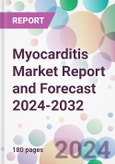Myocarditis Market Outlook
The myocarditis market size was valued at USD 1373.40 million in 2023, driven increasing development of the novel therapies. The market size is anticipated to grow at a CAGR of 4.9% during the forecast period of 2024-2032 to achieve a value of USD 2116.0 million by 2032.Myocarditis: Introduction
Myocarditis is an inflammatory condition of the heart muscle, typically caused by viral infections, but can also result from bacterial infections, autoimmune diseases, or exposure to toxins. Symptoms range from mild chest pain and fatigue to severe heart failure. It disrupts the heart's electrical system and weakens its pumping ability, potentially leading to arrhythmias or cardiomyopathy. Diagnosis often involves blood tests, imaging, and sometimes a biopsy, while treatment focuses on managing symptoms and the underlying cause.Key Trends in the Myocarditis Market
There's a growing trend in research and development activities focusing on understanding the pathophysiology of myocarditis and developing targeted therapies. Pharmaceutical companies and research institutions are investing in the development of drugs that can effectively treat the underlying causes of myocarditis and manage its symptoms, reducing the risk of complications like heart failure.Technological advancements in imaging and diagnostic techniques are improving the detection of myocarditis. The use of advanced MRI techniques, biomarkers, and genomic testing helps in the early and accurate diagnosis of the condition. These advancements enable healthcare providers to tailor treatment approaches, improve patient outcomes, and reduce the risk of chronic heart conditions.
There's an increasing trend towards personalized medicine in treating myocarditis. Understanding the genetic and molecular basis of myocarditis is leading to more personalized treatment approaches. This trend is about tailoring treatments based on individual patient profiles, their response to therapy, and the specific ethology of myocarditis in each case.
Awareness campaigns by healthcare organizations and patient advocacy groups are leading to increased awareness and early screening for myocarditis, especially after viral infections or in individuals receiving certain types of medical treatments. Early detection and intervention can significantly improve patient outcomes and reduce the long-term impacts of the disease.
The management of myocarditis is increasingly becoming multidisciplinary, involving cardiologists, infectious disease specialists, immunologists, and other healthcare professionals. This collaborative approach ensures comprehensive care, addressing not just the heart condition but also the underlying causes and associated health issues.
Myocarditis Market Segmentation
Market Breakup by Type
- Spinocerebellar Myocarditis
- Myocarditis-Telangiectasia
- Episodic Myocarditis
- Others
Market Breakup by Services
- Treatment
- Diagnosis
Market Breakup by Dosage Forms
- Solid
- Liquids
- Others
Market Breakup by Age Group
- Adult
- Child
- Geriatric
Market Breakup by End User
- Hospitals
- Clinics
- Others
Market Breakup by Region
- United States
- EU-4 and the United Kingdom
- Germany
- France
- Italy
- Spain
- United Kingdom
- Japan
Myocarditis Market Overview
North America, particularly the United States, is a leading region in the myocarditis market, characterized by advanced healthcare infrastructure and a high degree of awareness about cardiovascular conditions. There's a significant emphasis on research and development of treatments, supported by government initiatives and private funding. The region also sees robust clinical trials and a strong presence of pharmaceutical companies focusing on innovative therapies for myocarditis and related cardiac conditions.Europe has a well-established healthcare system and places a strong emphasis on the early diagnosis and treatment of heart-related ailments, including myocarditis. Countries like Germany, the UK, and France are at the forefront in terms of research and healthcare provision. The region benefits from collaborative research efforts, facilitated by entities like the European Society of Cardiology, and has stringent regulatory frameworks governing the approval of new treatments and drugs.
The Japan is experiencing rapid growth in the healthcare sector. The region presents significant opportunities for the expansion of healthcare services and has seen an increase in investment in healthcare infrastructure. However, there's variability in healthcare access and quality across different countries in the region.
Myocarditis Market: Competitor Landscape
The key features of the market report include patent analysis, grants analysis, clinical trials analysis, funding and investment analysis, partnerships, and collaborations analysis by the leading key players.- F. Hoffmann-La Roche Ltd.
- Mylan N.V.
- Teva Pharmaceutical Industries Ltd.
- Sanofi
- Pfizer Inc.
- GlaxoSmithKline plc
- Novartis AG
- AstraZeneca
- Johnson & Johnson
- LEO Pharma A/S
- AbbVie Inc.
- Bristol-Myers Squibb Company
- Eli Lilly and Company
- Cipla Inc.
- Bayer AG
This product will be delivered within 5-7 business days.
Table of Contents
1 Preface
3 Myocarditis Overview
4 Patient Profile
5 Myocarditis Epidemiology Analysis - 7MM
6 Myocarditis Market Overview - 7MM
7 Myocarditis Market Landscape - 7MM
8 Myocarditis Challenges and Unmet Needs
10 Myocarditis Market Dynamics
11 Myocarditis Market Segmentation - 7MM
12 United States Myocarditis Market
13 EU-4 and United Kingdom Myocarditis Market
14 Japan Myocarditis Market
15 Patent Analysis
16 Grants Analysis
17 Clinical Trials Analysis
18 Funding Analysis
19 Partnership and Collaborations Analysis
20 Supplier Landscape
21 Myocarditis Market - Distribution Model (Additional Insight)
23 Company Competitiveness Analysis (Additional Insight)
24 Payment Methods (Additional Insight)
Companies Mentioned
- F. Hoffmann-La Roche Ltd.
- Mylan N.V.
- Teva Pharmaceutical Industries Ltd.
- Sanofi
- Pfizer Inc.
- GlaxoSmithKline plc
- Novartis AG
- AstraZeneca
- Johnson & Johnson
- LEO Pharma A/S
- AbbVie Inc.
- Bristol-Myers Squibb Company
- Eli Lilly and Company
- Cipla Inc.
- Bayer AG
Table Information
| Report Attribute | Details |
|---|---|
| No. of Pages | 180 |
| Published | February 2024 |
| Forecast Period | 2024 - 2032 |
| Estimated Market Value ( USD | $ 1.44 Billion |
| Forecasted Market Value ( USD | $ 2.12 Billion |
| Compound Annual Growth Rate | 4.9% |
| Regions Covered | Global |
| No. of Companies Mentioned | 15 |









